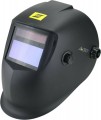Filter class
Class is a complex indicator that determines the overall quality of the light filter in a chameleon mask (see "Type"). The class is indicated by 4 numbers, each of which describes a specific optical parameter. So, the first number indicates the overall clarity and lack of distortion; the second is the degree of light scattering; third — uniformity of blackout (presence/absence of visible blackout spots); the fourth is the angular dependence (how much the filter brightens when the angle of view deviates from the perpendicular). In each case, the larger the number, the worse this parameter is. The perfect indicator is considered to be 1/1/1/1, but in fact it is very difficult to achieve an perfect angular dependence, and there is no need to. Therefore, an indicator of 1/1/1/2 is considered quite sufficient even for a high-end professional filter.
Filter viewing area (WxH)
The size of the transparent part of the light filter — the "working window", the area through which the welder sees the place of work. A larger working window provides ease of use and a wide field of view, but it significantly affects the cost of the mask and somewhat reduces the strength of the light filter.
Filter cartridge dimensions (WxH)
The overall dimensions of the light filter for which the mask is designed, taking into account the working window, protrusions for mounting, batteries, sensors and other structural elements. This indicator is especially important for models that are not equipped with light filters: without knowing the size, it is very difficult to choose the right cartridge. In other cases, data on the size of the cartridge is needed mainly when looking for a replacement for a failed colour filter.
Grinding mode
A special mode of operation of the chameleon mask, in which the light filter sensors are completely turned off — thus, it constantly remains transparent and does not respond to any flashes. This mode is useful for jobs that can produce fairly bright flashes of light, but do not require dimming. A classic example of such work is grinding with a “grinder” or a machine tool, when sparks can fly from the workpiece; hence the name of this function —
"grinding" mode.

